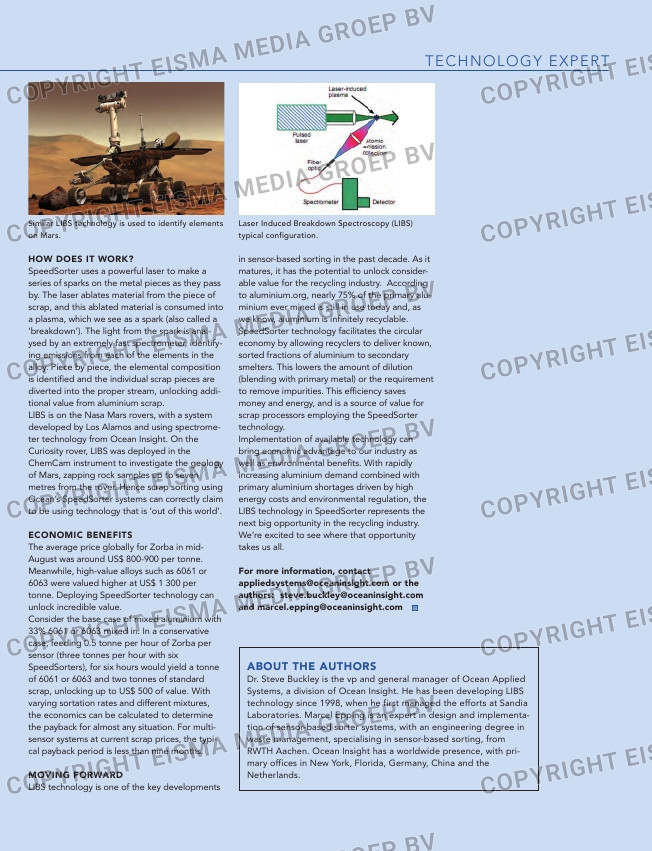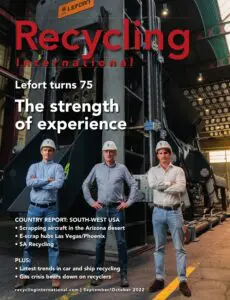Page 47 from: Recycling International September/October issue | 2022

TECHNOLOGY EXPERT
Applied Systems. ‘Our team can do an assess-
ment based on the scrap intake at a particular
site and advise on the economics and whether
the SpeedSorter makes sense for the customer.
We work closely with customers during the inte-
gration, setup, and commissioning phases of
each project, with service offerings to keep sys-
tems running long into the future.
THE SPEEDSORTER SYSTEM
A fully contained module that is dust-resistant
and rugged, SpeedSorter is designed to be inte-
grated into existing lines, or to be developed
easily within a production site by integrators.
Mounting the system is simple as only power
and communication lines are run to each unit.
SpeedSorter sends control signals to down-
stream hardware to direct diversion.
One of the hallmarks of the system is the simplic-
ity of the design with only a few moving parts.
This is a big advantage in the long run, as mov-
ing components are an obvious potential cause
of failure in real-world environments. The
straightforward design compared with competi-
tive systems allows SpeedSorter to be integrated
in a variety of environments with ease.
Additionally, the modular design makes the
entire sorting system redundant. For example, if
one of the sorting lines were to fail, additional
lines can continue to sort within the multi-sensor
system.
HOW DOES IT WORK?
SpeedSorter uses a powerful laser to make a
series of sparks on the metal pieces as they pass
by. The laser ablates material from the piece of
scrap, and this ablated material is consumed into
a plasma, which we see as a spark (also called a
‘breakdown’). The light from the spark is anal-
ysed by an extremely fast spectrometer, identify-
ing emissions from each of the elements in the
alloy. Piece by piece, the elemental composition
is identified and the individual scrap pieces are
diverted into the proper stream, unlocking addi-
tional value from aluminium scrap.
LIBS is on the Nasa Mars rovers, with a system
developed by Los Alamos and using spectrome-
ter technology from Ocean Insight. On the
Curiosity rover, LIBS was deployed in the
ChemCam instrument to investigate the geology
of Mars, zapping rock samples up to seven
metres from the rover. Hence scrap sorting using
Ocean’s SpeedSorter systems can correctly claim
to be using technology that is ‘out of this world’.
ECONOMIC BENEFITS
The average price globally for Zorba in mid-
August was around US$ 800-900 per tonne.
Meanwhile, high-value alloys such as 6061 or
6063 were valued higher at US$ 1 300 per
tonne. Deploying SpeedSorter technology can
unlock incredible value.
Consider the base case of mixed aluminium with
33% 6061 or 6063 mixed in. In a conservative
case, feeding 0.5 tonne per hour of Zorba per
sensor (three tonnes per hour with six
SpeedSorters), for six hours would yield a tonne
of 6061 or 6063 and two tonnes of standard
scrap, unlocking up to US$ 500 of value. With
varying sortation rates and different mixtures,
the economics can be calculated to determine
the payback for almost any situation. For multi-
sensor systems at current scrap prices, the typi-
cal payback period is less than nine months.
MOVING FORWARD
LIBS technology is one of the key developments
in sensor-based sorting in the past decade. As it
matures, it has the potential to unlock consider-
able value for the recycling industry. According
to aluminium.org, nearly 75% of the primary alu-
minium ever mined is still in use today and, as
we know, aluminium is infinitely recyclable.
SpeedSorter technology facilitates the circular
economy by allowing recyclers to deliver known,
sorted fractions of aluminium to secondary
smelters. This lowers the amount of dilution
(blending with primary metal) or the requirement
to remove impurities. This efficiency saves
money and energy, and is a source of value for
scrap processors employing the SpeedSorter
technology.
Implementation of available technology can
bring economic advantage to our industry as
well as environmental benefits. With rapidly
increasing aluminium demand combined with
primary aluminium shortages driven by high
energy costs and environmental regulation, the
LIBS technology in SpeedSorter represents the
next big opportunity in the recycling industry.
We’re excited to see where that opportunity
takes us all.
For more information, contact
[email protected] or the
authors: [email protected]
and [email protected]
ABOUT THE AUTHORS
Dr. Steve Buckley is the vp and general manager of Ocean Applied
Systems, a division of Ocean Insight. He has been developing LIBS
technology since 1998, when he first managed the efforts at Sandia
Laboratories. Marcel Epping is an expert in design and implementa-
tion of sensor-based sorter systems, with an engineering degree in
waste management, specialising in sensor-based sorting, from
RWTH Aachen. Ocean Insight has a worldwide presence, with pri-
mary offices in New York, Florida, Germany, China and the
Netherlands.
Laser Induced Breakdown Spectroscopy (LIBS)
typical configuration.
Designed for multi-sensor systems, the
SpeedSorter is often in 6 sensor sorting systems.
Similar LIBS technology is used to identify elements
on Mars.
46-47_oceaninsight.indd 47 12-09-2022 14:42



